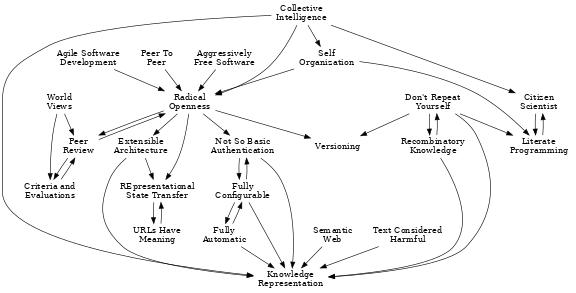| AnonymousUser || | || join |
The Nooron Pattern Language
Nooron is a comprehensive approach to working with information. It is built to simplify reuse. It accelerates software creation and distribution. It can be understood as the interaction of the following patterns.

- Agile Software Development
- Individuals and interactions over processes and tools. Working software over comprehensive documentation. Customer collaboration over contract negotiation. Responding to change over following a plan.
- Fully Automatic
- For new or casual users the utility of software is grounded in its clarity, predictability and reliability. Making every aspect of a system 'good enough' makes it easy for new users to get started. Having 'good enough' features trickle down from power users automatically is one way to provide usability for everyone.
- Peer To Peer
- Facilitate system scalability and self-organization by permitting or requiring that the computing resources of the users are contributed to the overall system.
- Extensible Architecture
- Build flexibility into the very nature of a system by basing it on well-defined interfaces and simple interactions.
- Radical Openness
- Permit a system to benefit from the contributions of all comers by erring in the direction of open write permissions and relying on trust, peer review, and ratings to put control over the signal to noise ratio into the hands of the viewer rather than having to be the responsibility of a moderator or administrator.
- Not So Basic Authentication
- Users own and maintain their identity and preference information at a location of their choosing and minimize registration effort at sites they visit.
- Criteria and Evaluations
- The implicit criterion in most rating systems is 'goodness'. Every adjectival phrase is a potential criterion and hence a potential dimension along which evaluations may occur. This infinitely extensible space is the space of human opinions. Criteria and evaluations can be used to filter, order, improve and inform rich representations of information. Goodness is not enough.
- Knowledge Representation
- Represent knowledge in the form of conceptual categories (called classes) and instances of those classes (called individuals) in such a way that computers can manipulate the knowledge by storing it, retrieving it and performing inferences on it.
- URLs Have Meaning
- Enable users to request output in particular file formats simply by tacking appropriate sequences of file extensions onto the ends of URLs.
- Collective Intelligence
- Maybe together we have enough intelligence to solve some of the really big problems.
- World Views
- An information system which specifically supports the creation and improvement of caricatured 'Points of View', 'Perspectives' or 'World Views' makes possible a new kind of intellectual tourism where we view the familiar in new ways or find new things which are invisible from our habitual perspectives. These every-colored-glasses may accelerate the evolution of the traveller just as they may accelerate the evolution of knowledge, the identification of the roots of conflict and the creation of consensus.
- Don't Repeat Yourself
- Every piece of knowledge must have a single, unambiguous, authoritative representation within a system.
- Semantic Web
- Transform the experience of users of the World Wide Web from surfing-between-interlinked-statically-formatted-pages, to interacting-meaningfully-with-meaning.
- Recombinatory Knowledge
- Keep different kinds of knowledge properly separated into containers which can be 'composed' with other knowledge to support multiple uses, and diverse purposes unimagined by their creators.
- REpresentational State Transfer
- Make URLs a powerful part of the user interface for a web-based application by ensuring that clearly understandable parts of the URL are equivalent to subject, verb and object.
- Versioning
- Keep track of the distinct, successive (possibly branching) states that information goes through.
- Self Organization
- Self-organization is the basis for the most complex, powerful systems known. Brains, life, and the universe itself exhibit the properties of spontaneous complexity generation, information manipulation and replication which underlie self-organization. Software systems which embrace these design principles can similarly be sources of surprising novelty.
- Peer Review
- Filter and improve human intellectual efforts by having fellow lovers of quality provide feedback and rating.
- Fully Configurable
- For technical or 'power' users the utility of software is grounded in its openness, automatability, and customizability. Making every aspect of a system understandable, configurable and replaceable makes it possible for the needs of serious users to be satisfied indefinitely. People who are 'power users' in some contexts can still appreciate simplicity during more mundane tasks.
- Literate Programming
- Generate the documentation for a system from the source code for the system so programmers are supported by their tools to create and learn from better documentation, and probably create better and more understandable code.
- Aggressively Free Software
- Free Software (ala the GPL) as opposed to narrowly Open Source Software is unambiguous about its availability and clearly committed to the creation of a digital commons.
- Citizen Scientist
- The professionalization of science interposes scientists between us and our participation in the improvement of knowledge. Citizen Scientists take an active role in creating their understanding of the world.
- Text Considered Harmful
- When people make the effort to express themselves in knowledge rather than text, they make it easier for machines (without AI) to process their utterences usefully. In turn, this means computers can do a much better job of helping us reuse, improve and (through richly 'typed' representations) understand our collected knowledge. Writing text is a form of expression whose usefullness lies somewhere on the spectrum between screaming incoherently in the wilderness and crafting fully machine-understandable knowledge in Cyc.
$Id: pattern_language_intents.html,v 1.10 2003/07/09 16:35:13 smurp Exp $
pattern_language_app
pattern_language_graph:
dot ps png svg pdf
pattern_language_article:
dbk rtf pdf tex txt
pattern_language_intents:
html
pattern_language:
html
nooron_app_instance
nooron_app:
html
generic_article:
dbk rtf pdf tex txt
:KB
entity_relationship:
dot ps png svg pdf
classes_in_kb:
dot ps png svg pdf
class_hierarchy:
dot ps png svg pdf
kb_ancestry:
dot ps png svg pdf
kb:
html
:THING
frame:
html
frame_details:
html
available actions:
put_frame_details.html
save_data.html